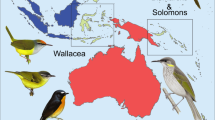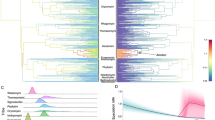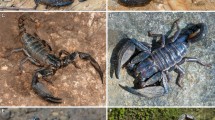Abstract
THE South American Andes were brought to their present height by the final uplift phases of the late Pliocene and the Pleistocene1–6 and an alpine-like vegetation (locally called páramo or puna7–14) developed in the terrain thus produced. It follows that the evolution of the associated páramo-puna fauna by multiple speciation in situ should have taken place mostly or entirely during the Quaternary, so that the occurrence of speciation within this fauna should be a convenient guide to the possible rate of speciation in the Pleistocene.
This is a preview of subscription content, access via your institution
Access options
Subscribe to this journal
Receive 51 print issues and online access
$199.00 per year
only $3.90 per issue
Buy this article
- Purchase on Springer Link
- Instant access to full article PDF
Prices may be subject to local taxes which are calculated during checkout
Similar content being viewed by others
References
Childs, O. E. and Beebe, B. W. (eds.), Backbone of the Americas (Amer. Assoc. Petrol. Geol. Memoir 2, 1963).
Gansser, A., Bull. Suisse Minéral. Pétrogr., 35, 209 (1955).
Hammen, Th. van der, Bol. Geol. Serv. Geol. Nac. Colombia, 6, 67 (1960).
Steinmann, G., Geología del Perú (Carl Winters Universitätsbuchhandlung, Heidelberg, 1930).
Ahlfeld, F., and Braniša, L., Geología de Bolivia (Inst. Boliviano del Petróleo, La Paz, 1960).
Brüggen, J., Fundamentos de la Geología de Chile (Inst. Geogr. Militar, Santiago, 1950).
Diels, L., Sitz, Ber. preuss. Akad. Wiss., 1934, 57 (1934).
Weber, H., Akad. Wiss. Liter. Mainz, Abh., Math.-Naturwiss. Klasse, No. 3, 117 (1958).
Troll, C., Bonn. Geogr. Abh., 25, 1 (1959).
Weberbauer, A., El Mundo Vegetal de los Andes Peruanos (Editorial Lumen, S. A., Lima, 1945).
Koepcke, H.-W., Bonn. Geogr. Abh., 29, 1 (1961).
Hertzog, T., Die Pflanzenwelt der bolivianischen Anden und ihres östliches Vorlandes (Die Vegetation der Erde, XV) (Engelmann, Leipzig, 1923).
Cabrera, A. L., Rev. Invest. Agric., 11, 317 (1957).
Cabrera, A. L., Bol. Soc. Argentina Bot., 4, 21 (1951).
Vuilleumier, F., Acta IV Cong. Latinoamer. Zool., Caracas, 1969 (in the press).
Vuilleumier, F., Breviora, No. 297, 1 (1968).
Mayr, E., Animal Species and Evolution (Belknap Press of Harvard Univ. Press, Cambridge, Mass., 1963).
Sievers, W., Verh. Gesell. Deutsch. Naturf. Artzte, 83, 184 (1911).
Hastenrath, S., J. Glaciol., 6, 541 (1967).
Kessler, A., Erdkunde (Arch. Wiss. Geog.), 17, 165 (1963).
Wilhelmy, H., Petermanns Geogr. Mitt. Gotha, Ergänzungsheft, No. 262, 281 (1957).
Hammen, Th. van der, and González, E., Leidse Geol. Meded., 25, 261 (1960).
González, E., Hammen, Th. van der, and Flint, R. F., Leidse Geol. Meded., 32, 157 (1965).
Author information
Authors and Affiliations
Rights and permissions
About this article
Cite this article
VUILLEUMIER, F. Pleistocene Speciation in Birds living in the High Andes. Nature 223, 1179–1180 (1969). https://doi.org/10.1038/2231179a0
Received:
Revised:
Issue Date:
DOI: https://doi.org/10.1038/2231179a0
This article is cited by
-
Systematic Studies of the Genus Aegialomys Weksler et al., 2006 (Rodentia: Cricetidae: Sigmodontinae): Geographic Variation, Species Delimitation, and Biogeography
Journal of Mammalian Evolution (2018)
-
Mountain Biodiversity Patterns at Low and High Latitudes
AMBIO: A Journal of the Human Environment (2004)
Comments
By submitting a comment you agree to abide by our Terms and Community Guidelines. If you find something abusive or that does not comply with our terms or guidelines please flag it as inappropriate.



